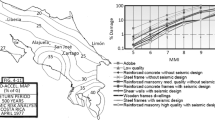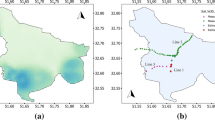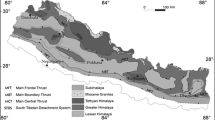Abstract
Iran is located in one of the most seismically active regions of the world. This high seismicity combined with densely populated regions has led to several destructive earthquakes in the past, such as the M7.4 Tabas (1978), M7.4 Manjil–Rudbar (1990), or the M6.6 Bam (2003). Seismic hazard and risk assessment can provide critical information to decision makers for the development of efficient risk reduction measures. In this study, exposure models for the residential, commercial and industrial building stock were developed using recent housing census information, socio-economic data and the judgement of local experts. For each building class in the exposure model, a set of fragility and vulnerability models was derived using nonlinear time history analysis and ground motion records from the region. The exposure and vulnerability models were combined with the recently released Earthquake Model for the Middle East (EMME) to estimate probabilistic earthquake losses using the OpenQuake-engine. These results identify the regions within the country with the highest risk, the most vulnerable building classes, and the expected economic losses for a number of return periods.

















Similar content being viewed by others
References
Akkar S, Zehra C (2010) A local ground-motion predictive model for Turkey, and its comparison with other regional and global ground-motion models. Bull Seismol Soc Am 100(6):2978–2995
Akkar S, Sadikkaya M, Bommer J (2014) Empirical ground-motion models for point- and extended-source crustal earthquake scenarios in Europe and the Middle East. Bull Earthq Eng 12(1):359–387
Allen T, Wald D (2009) On the use of high-resolution topographic data as a proxy for seismic site conditions (Vs30). Bull Seismol Soc Am 99:935–943
Ambraseys N, Melville N (1982) A history of Persian earthquake. Cambridge University Press, Cambridge, p 219
Ambraseys N, Moinfar A (1973) The Silakhor, Lurestan, earthquake of 23rd January 1909. Annali di Geofis 26:659–678
Ansari A, Firuzi E, Etemadsaeed L (2015) Delineation of seismic sources in probabilistic seismic-hazard analysis using fuzzy cluster analysis and Monte Carlo simulation. Bull Seismol Soc Am 105(4):2174–2191
Applied Technology Council (1985) ATC-13 Earthquake Damage Evaluation Data for California. California
Bakhshi A, Karimi K (2006) Method of developing fragility curves—a case study for seismic assement of masonry building in IRAN. In: 7th international congress on civil engineering
Bal I, Crowley H, Pinho R, Gulay F (2008) Detailed assessment of structural characteristics of Turkish rc building stock for loss assessment models. Soil Dyn Earthq Eng 28:914–932
Berberian M (1976a) Documented earthquake faults in Iran. Geol Surv Iran 39:143–186
Berberian M (1976b) First seismotectonic map of Iran, 1:2,500,000. Geol Surv Iran 39:518
Berberian M (2014) Earthquakes and coseismic surface faulting on the Iranian Plateau, vol 17, 1st edn. Elsevier, New York
Berberian M, King G (1981) Towards a paleogeography and tectonic evolution of Iran. Can J Earth Sci 18(2):210–265
Berberian M, Qorashi M (1992) Earthquake-fault map of Azarbaijan sheet, northwest Persia, 1:1,000,000. Internal Report Ministry of Power, Jamab Consulting Engineers, Tehran
Borzi B, Crowley H, Pinho R (2008) Simplified pushover-based vulnerability analysis for large-scale assessment of RC buildings. Eng Struct 30:804–820
Brzev S, Scawthorn C, Charleson A, Allen L, Greene M, Jaiswal K, Silva V (2013) GEM building taxonomy version 2.0. GEM Technical Report 2013-02-V1.0.0, Global Earthquake Model Foundation
Casotto C, Silva V, Crowley H, Nascimbene R, Pinho R (2015) Seismic fragility of Italian RC precast industrial structures. Eng Struct 94:122–136
Chiou B, Youngs R (2008) An NGA model for the average horizontal component of peak ground motion and response spectra. Earthq Spectra 24(1):173–215
Crowley H, Pinho R (2004) Period-height relationship for existing European reinforced concrete buildings. J Earthq Eng 8(1):93–119
Danciu L, Kale O, Akkar S (2016) The 2014 Earthquake Model of the Middle East: ground motion model and uncertainties. Bull Earthq Eng 5(1):1–2
Danciu L, Şeşetyan K, Demircioglu M et al (2017) The 2014 earthquake model of the Middle East: seismogenic sources. Bull Earthq Eng 3(3):1–5. https://doi.org/10.1007/s10518-017-0096-8
Engdahl R, Jackson J, Myers S, Bergman E, Priestley K (2006) Relocation and assessment of seismicity in the Iran region. Geophys J Int 167:761–778
Erberik M (2008) Generation of fragility curves for Turkish masonry buildings considering in-plane failure modes. Earthq Eng Struct Dyn 37(3):387–405
Ghafory-Ashtiany M, Nasser-Assadi K (2011) Iran new earthquake insurance index. Final management report, Insurance Faculty, Tehran, Iran
Ghafory-Ashtiany M, Tavakoli B (1999) Seismic hazard assessment of Iran. Ann Geophys 42(6):903–915
Ghafory-Ashtiany M, Jafari M, Shadi-Talab J, Eshghi S, Qurashi M (1992) Tenth world conference on earthquake engineering. Balkema, Rotterdam
Ghayamghamian M, Haghshenas E, Amini-Hossein K, Mansouri B (2011) Estimation of site amplification factor in tehran city for rapid damage estimation. Tehran Disaster Mitig Manag 1(2):199–214 (in Persian)
Ghodrati-Amiri G, Motamed R, Es-Haghi H (2003) Seismic hazard assessment of metropolitan Tehran, Iran. J Earthq Eng 7(3):347–372
Gholizad A, Safari H (2014) Seismic fragility curves for mid-rise RC frames designed according to Iranian seismic code. Asian J Civ Eng 15(6):803–815
Hamzehloo H, Alikhanzadeh A, Rahmani M, Ansari A (2012) Seismic hazard maps of Iran 15WCEE, Lisboa
Hisada Y, Shibaya A (2004) Building damage and seismic intensity in Bam City from the 2003 Iran, Bam, earthquake. Bull Earthq Res Inst 79:81–93
Ibrion M, Mokhtari M, Nadim F (2015) Earthquake disaster risk reduction in Iran: lessons and “lessons learned” from three large earthquake disasters—Tabas 1978, Rudbar 1990, and Bam 2003. Int J Disaster Risk Sci 6(4):415–427
Jaiswal K, Wald D (2008) Creating a global building inventory for earthquake loss assessment and risk management. Open-File Report 2008-1160, pp 103
Jayaram N, Baker J (2010) Correlation model for spatially distributed ground-motion intensities. Earthq Eng Struct Dyn 38:1687–1708
JICA2000 Japan International Cooperation Agency (2000) The study on seismic microzoning of the greater Tehran area in the Islamic Republic of Iran. Final Report
Kazemi H, Ghafory-Ashtiany M, Azarbakht A (2013) Effect of epsilon-based record selection on fragility curves of typical irregular steel frames with concrete shear walls in Mashhad city. Int J Adv Struct Eng 5:23
Khatam A (2006) The destruction of Bam and its reconstruction following the earthquake of December 2003. Cities 23(6):462–464
Kircher C, Aladdin A, Nassar O, Holmes H (1997) Development of building damage functions for earthquake loss estimation. Earthq Spectra 13(4):773–793
Lemoine A, Douglas J, Cotton F (2012) Testing the applicability of correlation between topographic slope and VS30 for Europe. Bull Seismol Soc Am 102:2585–2599
Mandani A, Faghihmaleki H (2015) A comparison of damage indices in development of seismic fragility curve for steel moment frames with divergent bracing. Buletin Teknologi Makanan 2(5):283–289
Mansouri B, Ghafory-Ashtiany M, Amini-Hosseini K, Nourjou R, Mousavi M (2010) Building seismic loss model for Tehran. Earthq Spectra 26(1):153–168
Mirzaei N, Geo M, Chen Y (1999) Delineation of potential seismic sources for seismic zoning of Iran. J Seismol 3:17–30
Molina S, Lang D, Lindholm C (2010) SELENA—an open-source tool for seismic risk and loss assessment using a logic tree computation procedure. Comput Geosci 36(3):257–269
Mostafaei H, Kabeyasawa T (2004) Investigation and analysis of damage to buildings during the 2003 Bam earthquake. Bull Earthq Res Inst 79:107–132
Motamed H, Khazai B, Ghafory-Ashtiany M, Amini-Hosseini A (2014) An automated model for optimizing budget allocation in earthquake mitigation scenarios. Nat Hazards 70(1):51–68
Nassirpour A, Dayala D (2014) Fragility analysis of mid-rise in-filled steel frame (MISF) structures. In: Second European conference on earthquake engineering and seismology, Istanbul
Nowroozi A (1971) Seismo-tectonics of the Persian plateau, eastern Turkey, Caucasus, and Hindu-Kush regions. Bull Seismol Soc Am 61(2):317–341
Nowroozi A (1976) Seismotectonic provinces of Iran. Bull Seismol Soc Am 66:1249–1276
Oliviera C, Navaro M (2010) Fundamental periods of vibration of RC buildings in Portugal from in situ experimental and numerical techniques. Bull Earthq Eng 8(3):609–642
Omidvar B, Gatmiri B, Derakhshan S (2011) Experimental vulnerability curves for the residential buildings of Iran. Nat Hazards 60:345–365. https://doi.org/10.1007/s11069-011-0019-y
Pagani M, Monelli D, Weatherill G, Danciu L, Crowley H, Silva V, Henshaw P, Butler L, Nastasi M, Panzeri L, Simionato M, Vigano D (2014) OpenQuake-engine: an open hazard (and risk) software for the global earthquake model. Seismol Res Lett 85(3):692–702
Pakdel-Lahiji N, Hochrainer-Stigler S, Ghafory-Ashtiany M, Sadeghi M (2015) Consequences of financial vulnerability and insurance loading for the affordability of earthquake insurance systems: evidence from Iran. Geneva Pap Risk Insur 40(2):295–315
Pestalozzi N, Cauwels P, Sornette D (2012) Dynamics and spatial distribution of global nighttime lights. Department of Management, Technology and Economics, Chair of Entrepreneurial Risks, Zurich
Sadeghi M, Ghafory-Ashtiany M, Pakdel-Lahiji N (2015) Developing seismic vulnerability curves for typical Iranian buildings. SAGE J Risk Reliab 229(6):627–640
Silva V (2017) Critical issues on probabilistic earthquake loss assessment. J Earthq Eng 22(9):1683–1709
Silva V, Crowley H, Varum H, Pinho R (2013) Extending displacement-based earthquake loss assessment (DBELA) for the computation of fragility curves. Eng Struct 56:343–356
Silva V, Crowley H, Pagani M, Monelli D, Pinho R (2014) OpenQuake-engine: an open hazard (and risk) software for the global earthquake model. Nat Hazards 13(5):1455–1490
Silva V, Casotto C, Rao A, Villar M, Crowley H, Vamvatsikos D (2015) Risk Modeller’s Toolkit. Technical Report, https://doi.org/10.13117/gem.openquake.man.rmtk.1.0/02
Standard 2800 (2015) Iranian code of practice for seismic resistant design of buildings. Building and Housing Research Center, 4th version
Statistical Center of Iran (2016) Population and housing censuses, 2011–2016. https://www.amar.org.ir/english/Population-and-Housing-Censuses
Stocklin J (1968) Structural history and tectonic of Iran: a review. Am Assoc Pet Geol Bull 52:1229–1258
Takin M (1972) Iranian geology and continental drift in the Middle East. Nature 235:147–150. https://doi.org/10.1038/235147a0
Tavakoli B, Tavakoli S (1993) Estimating the vulnerability and loss functions of residential buildings. Nat Hazards 7:155
Tavakoli B, Ghafory-Ashtiany M (1996) Major Seismotectonic provinces of Iran. IIEES, Internal Document
United Nations Office for Disaster Risk Reduction (UNSDR). Global Assessment Report. Annex 1: data, methodology and usage. https://www.preventionweb.net/english/hyogo/gar/2015/en/home/documents.html
Villar-Vega M, Silva V, Crowley H, Yepes C, Tarque N, Acevedo A, Hube M, Coronel G, Santa-María H (2017) Development of a fragility model for the residential building stock in South America. Earthq Spectra 33(2):581–604
Watson-Lamprey J, Abrahamson N (2006) Selection of ground motion time series and limits on scaling. Soil Dyn Earthq Eng 26:477–482
Woessner J, Danciu L, Giardini D, Crowley H, Cotton F, Grünthal G, Valensise G, Arvidsson R, Basili R, Demircioglu M, Hiemer S, Meletti C, Musson R, Rovida A, Sesetyan K, Stucchi M (2015) The 2013 European seismic hazard model: key components and results. Bull Earthq Eng. https://doi.org/10.1007/s10518-015-9795-1
Yamasaki F, Matsuoka M (2005) Building damage mapping of the 2003 Bam, Iran, earthquake using Envisat/ASAR intensity imagery. Earthquake Spectra 21(S1):285–294
Yepes-Estrada C, Silva V, Valcárcel J, Acevedo A, Tarque N, Hube M, Coronel G, Santa-María H (2017) Modeling the residential building inventory in South America for seismic risk assessment. Earthq Spectra 33(1):299–322
Zafarani H, Noorzad A, Ansari A, Bargi K (2009) Stochastic modeling of Iranian earthquakes and estimation of ground motion for future earthquakes in Greater Tehran. Soil Dyn Earthq Eng 29(4):722–741
Zare M, Amini H, Yazdi P, Sesetyan K (2014) Recent developments of the Middle East catalog. J Seismol 18(4):749–772
Zhao X, Zhang J, Asano A, Ohno Y, Oouchi T, Takahashi T, Ogawa H, Irikura K, Thio H, Somerville P, Fukushima Y, Fukushima Y (2006) Attenuation relations of strong ground motion in Japan using site classification based on predominant period. Bull Seismol Soc Am 96(3):898–913
Zolfaghari M (2003) Catastrophe risk management: an insurance-based post-disaster recovery pan. In: 4th international conference on earthquake engineering and seismology, Tehran, Iran
Acknowledgements
This work supported the project ‘Development of Earthquake Indirect Loss Model for Iran’ (code: P-8125) from the International Institute of Earthquake Engineering and Seismology (IIEES). The Authors would like to show their gratitude to IIEES for their support during the course of this research.
Author information
Authors and Affiliations
Corresponding author
Ethics declarations
Conflict of interest
The authors declare that they have no conflict of interest
Human and animal rights
This article does not contain any studies with human participants or animals performed by any of the authors.
Rights and permissions
About this article
Cite this article
Motamed, H., Calderon, A., Silva, V. et al. Development of a probabilistic earthquake loss model for Iran. Bull Earthquake Eng 17, 1795–1823 (2019). https://doi.org/10.1007/s10518-018-0515-5
Received:
Accepted:
Published:
Issue Date:
DOI: https://doi.org/10.1007/s10518-018-0515-5




